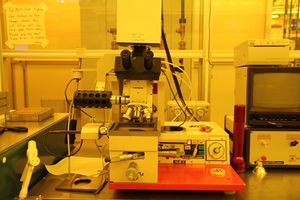IR Aligner (SUSS MJB-3 IR)
Jump to navigation
Jump to search
The printable version is no longer supported and may have rendering errors. Please update your browser bookmarks and please use the default browser print function instead.
|
About
This is a high-performance contact mask aligner with backside alignment capability for opaque materials using IR. It is a versatile, user-friendly compact unit that has a foot print of 600 x 800 mm². The resolution (depending on contact mode, optics and exposure wavelength and "operator technique") is down to 1 micron (hard contact). The aligner is configured for the near-UV window (365 and 405 nm). Exposures can be done on substrates from small "piece parts" of less than 1 cm square to substrates of 3 inch diameter or square. Masks up to 4 inches in size can be used although patterns should be well away from the mask plate edges due to the fact such plates can only be shifted a limited distance in the x and y.
Detailed Specifications
- Wafer size: 3" max. for vacuum mode; 4” for soft contact (3” x 3” exposure area)
- Substrate size: 3" x 3" max.
- Wafer / substrate thickness: 0-4.5 mm
- Exposure optics:
- 280-450 nm/200 W mercury lamp (can filter to 350 nm)
- Uniformity:
- ±3% over 2" diameter
- ±5% over 3" diameter
Special Notes / Additional Comments
- 200 W mercury lamp
- Top side alignment (visible) can be performed on this aligner as well with a quick tooling change
- Infrared Transmission Alignment System:
- Motor positioned IR light source under chuck
- Special glass chucks transparent to IR but opaque to UV and visible light
- In-line video camera/monitor for substrate backside viewing and alignment to front-side
- This aligner does not support vacuum contact mode
- For processes using this tool please go to the contact lithography process page
